Sulforaphane, L-Menthol, and Dexpanthenol as a Novel Active Cosmetic Ingredient Composition for Relieving Hair Loss Symptoms
Abstract
:1. Introduction
2. Materials and Methods
2.1. Chemicals and Reagents
2.2. Cell Culture
2.3. Cell Viability
2.4. Isolation of Total RNA and Reverse Transcription-Polymerase Chain Reaction
2.5. Western Blotting
2.6. Prototype Preparation of a Functional Cosmetic Formulation to Relieve Hair Loss
2.7. Clinical Application Test for Hair Loss
2.7.1. Purpose of the Trial
2.7.2. Description for the Trial Target
2.7.3. Evaluation Methods
2.7.4. Visual Evaluation for the Crown of the Head and Forehead Line
2.7.5. Quantitative Evaluation Using Phototricogram
2.7.6. Statistical Analysis
3. Results
3.1. Cytotoxicity of Raw264.7 Cells with Biotin, Dexpanthenol, L-Menthol, and Zinc Pyrithione Using Raw264.7 Cells
3.2. Cytotoxicity of Hepa1c1c7 Cells with Sulforaphane, Biotin, Dexpanthenol, L-Menthol, and Zinc Pyrithione
3.3. Identification of Ak1c21 and Dhrs9 at the RNA and Protein Levels Using Hepa1c1c7 Cells with Sulforaphane and a Mixture of Biotin, Dexpanthenol, and L-Menthol
3.4. Preparation of a Prototype Formulation to Reduce Hair Loss
3.5. Clinical Application Test for Hair Loss
4. Discussion
5. Conclusions
Supplementary Materials
Author Contributions
Funding
Institutional Review Board Statement
Informed Consent Statement
Conflicts of Interest
References
- Kelly, Y.; Blanco, A.; Tosti, A. Androgenetic Alopecia: An Update of Treatment Options. Drugs 2016, 76, 1349–1364. [Google Scholar] [CrossRef] [PubMed]
- Hoffmann, R. Male Androgenetic Alopecia. Clin. Exp. Dermatol. 2002, 27, 373–382. [Google Scholar] [CrossRef] [PubMed]
- Ruth, S.U.; Ralf, P. Molecular Principles of Hair Follicle Induction And Morphogenesis. Bioessays 2005, 27, 247–261. [Google Scholar]
- Hibino, T.; Nishiyama, T. Role of TGF- β2 in The Human Hair Cycle. J. Dermatol. Sci. 2004, 35, 9–18. [Google Scholar] [CrossRef]
- Gupta, A.K.; Charrette, A. The Efficacy and Safety of 5 α-Reductase Inhibitors in Androgenetic Alopecia: A Network Meta- Analysis and Benefit-Risk Assessment of Finasteride and Dutasteride. J. Dermatolog. Treat. 2014, 25, 156–161. [Google Scholar] [CrossRef]
- Varothai, S.; Bergfeld, W.F. Androgenetic Alopecia: An Evidence-Based Treatment Update. Am. J. Clin. Dermatol. 2014, 15, 217–230. [Google Scholar] [CrossRef]
- Messenger, A.G.; Rundegren, J. Minoxidil: Mechanisms of Action on Hair Growth. Br. J. Dermatol. 2004, 150, 186–194. [Google Scholar] [CrossRef]
- Russell, D.W.; Wilson, J.D. Steroid 5 alpha-reductase: Two Genes/two Enzymes. Annu. Rev. Biochem. 1994, 63, 25–61. [Google Scholar] [CrossRef]
- Eleonora, B.; Franco, G.; Luca, M. Protective Role of Nutritional Plants Containin Flavonoide in Hair Follicle Disruption: A Review. Int. J. Mol. Sci. 2020, 21, 523. [Google Scholar]
- Famenini, S.; Goh, C. Evidence for Supplemental Treatments in Androgenetic Alopecia. J. Drugs Dermatol. 2014, 13, 809–812. [Google Scholar] [PubMed]
- Prawan, A.; Keum, Y.S.; Khor, T.O.; Yu, S.; Nair, S.; Li, W.; Hu, L.; Kong, A.N.T. Structural Inflenece of Isothiocyanates on the Antioxidant Response Element (ARE)-Mediated HemeOxygenase-1 (HO-1) Expression. Pharm. Res. 2008, 25, 836–844. [Google Scholar] [CrossRef] [PubMed]
- Kaufman, K.D.; Olsen, E.A.; Whiting, D.; Savin, R.; De Villez, R.; Bergfeld, W.; Price, V.H.; Neste, D.V.; Roberts, J.L.; Hordinsky, M.; et al. Finasteride in the Treatment of Men with Androgenetic Alopecia Finasteride Male Pattern Hair Loss Study Group. J. Am. Acad. Dermatol. 1998, 39, 578–589. [Google Scholar] [CrossRef]
- Harris, G.; Azzolina, B.; Baginsky, W.; Cimis, G.; Rasmusson, H.; Tolman, R.L.; Raetz, C.R.; Ellsworth, K. Identification and Selective Inhibition of An Isozyme of Steroid 5 alpha-reductase in Human Scalp. Proc. Natl. Acad. Sci. USA 1992, 89, 10787–10791. [Google Scholar] [CrossRef] [Green Version]
- Kanti, V.; Messenger, A.; Dobos, G.; Reygagne, P.; Finner, A.; Blumeyer, A.; Trakatelli, M.; Tosti, A.; DelMarmol, V.; Piraccini, B.M.; et al. Evidence Based (S3) Guideline for the Treatment of Androgenetic Alopecia in Women and in Men-Short Version. J. Eur. Acad. Dermatol. Venereol. 2018, 32, 11–22. [Google Scholar] [CrossRef]
- Kaushik, R.; Gupta, D.; Yadav, R. Alopecia: Herbal Remedies. Int. J. Pharm. Sci. Res. 2011, 2, 1631–1637. [Google Scholar]
- Sun, C.C.; Li, S.J.; Yang, C.L.; Xue, R.L.; Xi, Y.Y.; Wang, L.; Zhao, Q.L.; Li, D.J. Sulforaphane Attenuates Muscle Inflammation in Dystrophin-deficient mdx Mice via NF-E2-related Factor 2(Nrf2)-mediated Inhibition of NFκB Signaling Pathway. J. Biol. Chem. 2015, 290, 17784–17795. [Google Scholar] [CrossRef] [PubMed] [Green Version]
- Jung, K.A.; Choi, B.H.; Nam, C.W.; Song, M.; Kim, S.T.; Lee, J.Y.; Kwak, M.K. Identification of Aldo-keto Reductases as NRF2 Target Marker Genes in Human Cells. Toxicol. Lett. 2013, 218, 39–49. [Google Scholar] [CrossRef] [PubMed]
- Kensler, T.W.; Egner, P.A.; Agyeman, A.S.; Visvanathan, K.; Groopman, J.D.; Chen, J.G.; Chen, T.Y.; Fahey, J.W.; Talalay, P. Keap1–Nrf2 Signaling: A Target for Cancer Prevention by Sulforaphane. Top. Curr. Chem. 2013, 329, 163–177. [Google Scholar] [PubMed] [Green Version]
- Nagase, T.; Akase, T.; Sanada, H.; Minematsu, T.; Ibuki, A.; Huang, L.; Asada, M.; Yoshimura, K.; Nagase, M.; Shimada, T.; et al. Aging-like skin changes in metabolic syndrome model mice are mediated by mineralocorticoid receptor signaling. Aging Cell 2013, 12, 50–57. [Google Scholar] [CrossRef] [Green Version]
- Sasaki, M.; Shinozaki, S.; Shimokado, K. Sulforaphane Promotes Murine Hair Growth by Accelerating The Degradation of Dihydro Testosterone. Biochem. Biophys. Res. Commun. 2016, 472, 250–254. [Google Scholar] [CrossRef]
- Penning, T.M.; Burczynski, M.E.; Jez, J.M.; Hung, C.F.; Lin, H.K.; Ma, H.; Moore, M.; Palackal, N.; Ratnam, K. Human 3alpha hydroxysteroid Dehydrogenase Isoforms(AKR1C1-AKR1C4) of The Aldo-keto Reductase Superfamily: Functional Plasticity and Tissue Distribution Reveals Roles in The Inactivation and Formation of Male and Demale Sex Hormone. Biochem. J. 2000, 351, 67–77. [Google Scholar] [CrossRef]
- Jornvall, H.; Persson, B.; Krook, M.; Atrian, S.; Gonzalez-Duarte, R.; Jeffery, J.; Ghosh, D. Short-chain Dehydrogenases/ Reductases (SDR). Biochemistry 1995, 34, 6003–6013. [Google Scholar] [CrossRef]
- Rojhirunsakool, S.; Suchonwanit, P. Parietal Scalp is Another Affected Area in Female Pattern Hair Loss: An Analysis of Hair Density and HairDiameter. Clin. Cosmet. Investig. Dermatol. 2018, 11, 7–12. [Google Scholar] [CrossRef] [PubMed] [Green Version]
- Alberton, B.A.V.; Nichols, T.E.; Gamba, H.R.; Winkler, A.M. Multiple Testing Correction Over Contrasts for Brain Imaging. NeuroImage 2020, 216, 116760–116774. [Google Scholar] [CrossRef] [PubMed]
- Mackay-Wiggan, J.; Jabbari, A.; Nguyen, N.; Cerise, J.E.; Clark, C.; Ulerio, G.; Furniss, M.; Vaughan, R.; Christiano, A.M.; Clynes, R. Oral Ruxolitinib Induces Hair Regrowth in Patients with Moderate-to-severe Alopecia Areata. JCI Insight 2016, 1, e89790–e89800. [Google Scholar] [CrossRef] [Green Version]
- Lee, J.H.; Choi, K.H.; Park, Y.K.; Kim, E.G.; Shin, E.Y. Development of Novel Sulforaphane Contained Composition to Increase Antioxidant and Whitening Effects. J. Soc. Cosmet. Sci. Korea 2018, 4, 437–445. [Google Scholar]
- Patel, D.P.; Swink, S.M.; Leslie, C.S. A Review of the Use of Biotin for Hair Loss. Skin Appendage Disord. 2017, 3, 166–169. [Google Scholar] [CrossRef]
- Park, M.; Cho, Y.J.; Lee, Y.W.; Jung, W.H. Understanding the Mechanism of Action of the Anti-Dandruff Agent Zinc Pyrithione against Malassezia restricta. Sci. Rep. 2018, 8, 12086. [Google Scholar] [CrossRef]
- Fritz, E.; Andreas, H.; Frank, R.; Irene, T. Topical Use of Dexpanthenol in Skin Disorders. Am. J. Clin. Dermatol. 2002, 3, 427–433. [Google Scholar]
- Ehrhardt, P.; Raymone, D.B.; Sonja, T.; Stephanie, B. Topical use of Dexpanthenol: A 70th Anniversary Article. J. Dermatol. Treat. 2017, 28, 766–773. [Google Scholar]
- Stüttgen, G.; Krause, H. Die percutane Absorption von Tritium-markiertem Panthenol bei Mensch und Tier. Arch. Klin. Exp. Dermatol. 1960, 209, 578–582. [Google Scholar] [CrossRef]
- Ahn, S.; Lee, J.Y.; Choi, S.M.; Shin, Y.; Park, S. A Mixture of Tocopherol Acetate and L-Menthol Synergistically Promotes. Hair Growth in C57BL/6 Mice. Pharmaceutics 2020, 12, 1234. [Google Scholar] [CrossRef] [PubMed]
- Ebert, B.; Kisiela, M.; Wsol, V.; Maser, E. Proteasome Inhibitors MG 132 and Bortezomib Induce AKR1C1, AKR1C3, AKR1B1, and AKR1B10 in Human Colon Cancer Cell Lines SW-480 and HT-29. Chem. Biol. Interact. 2011, 191, 239–249. [Google Scholar] [CrossRef] [PubMed]
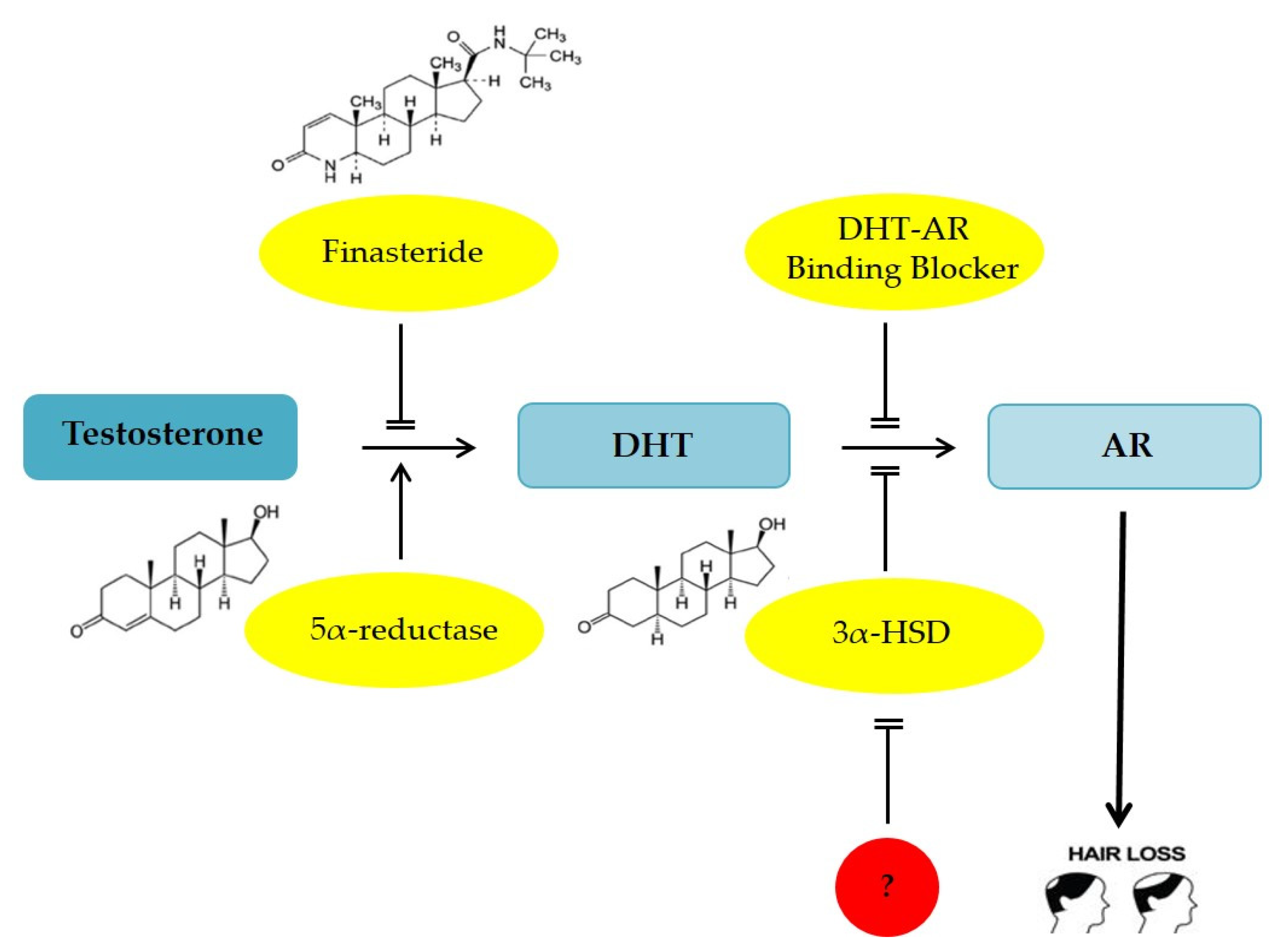
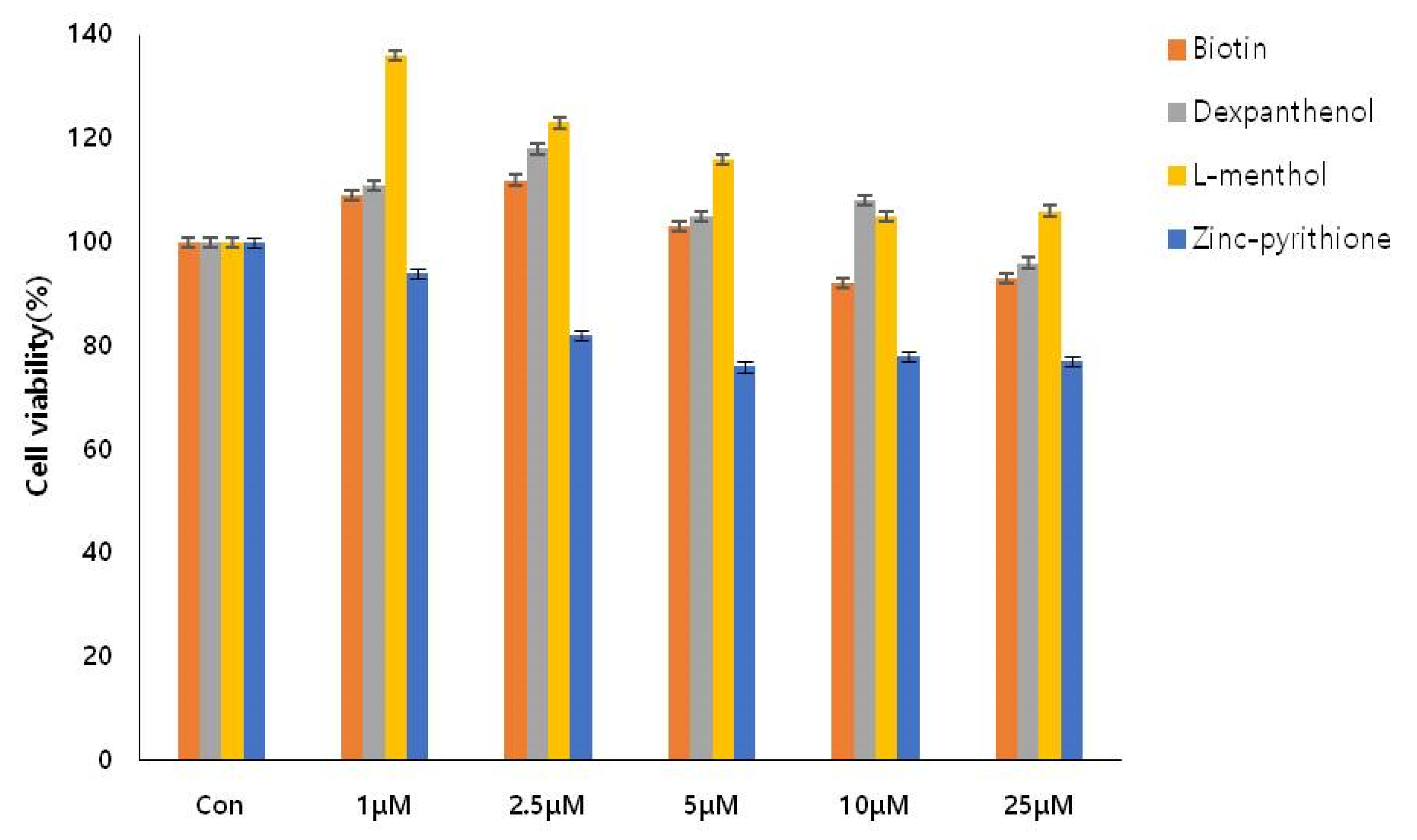
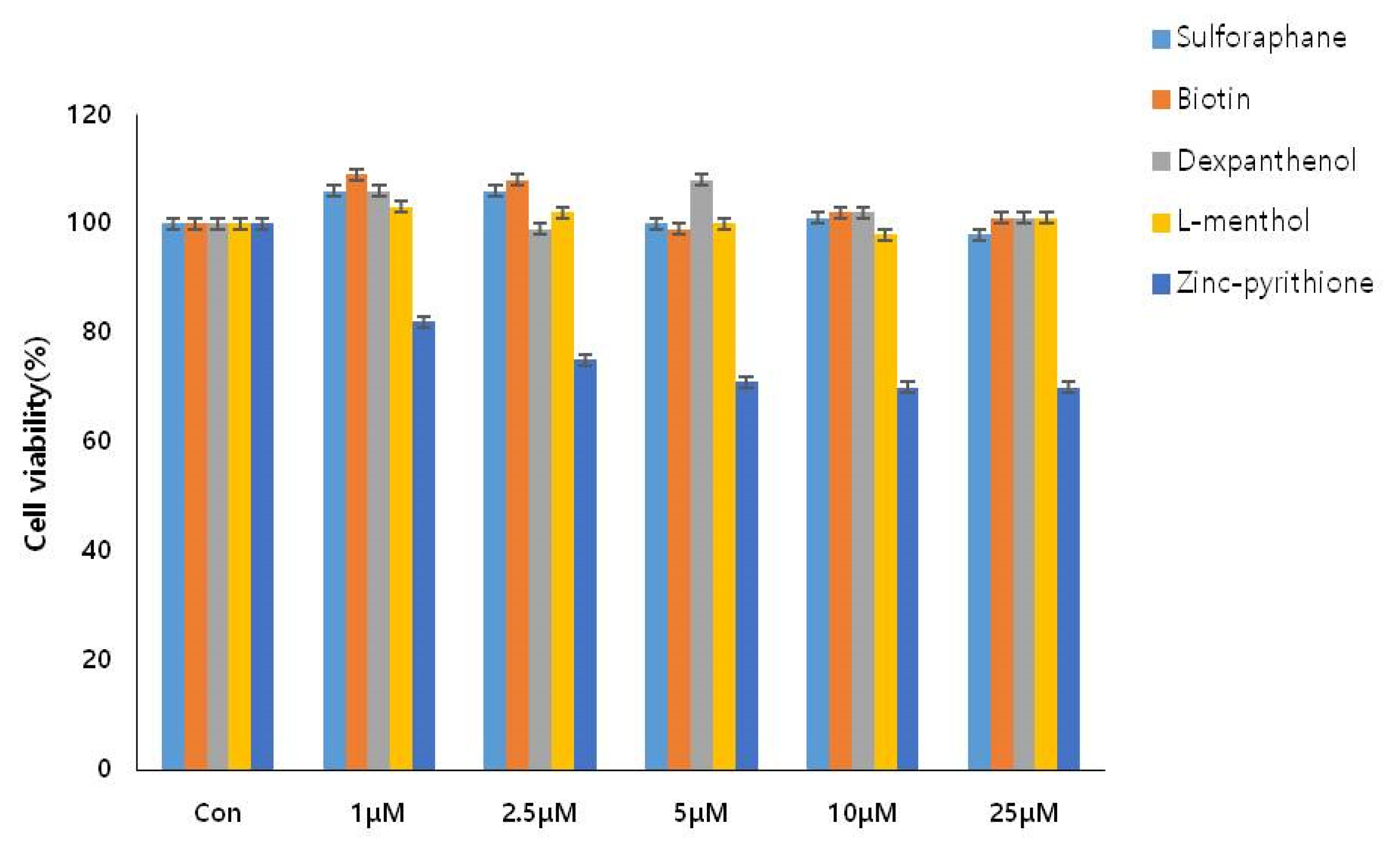
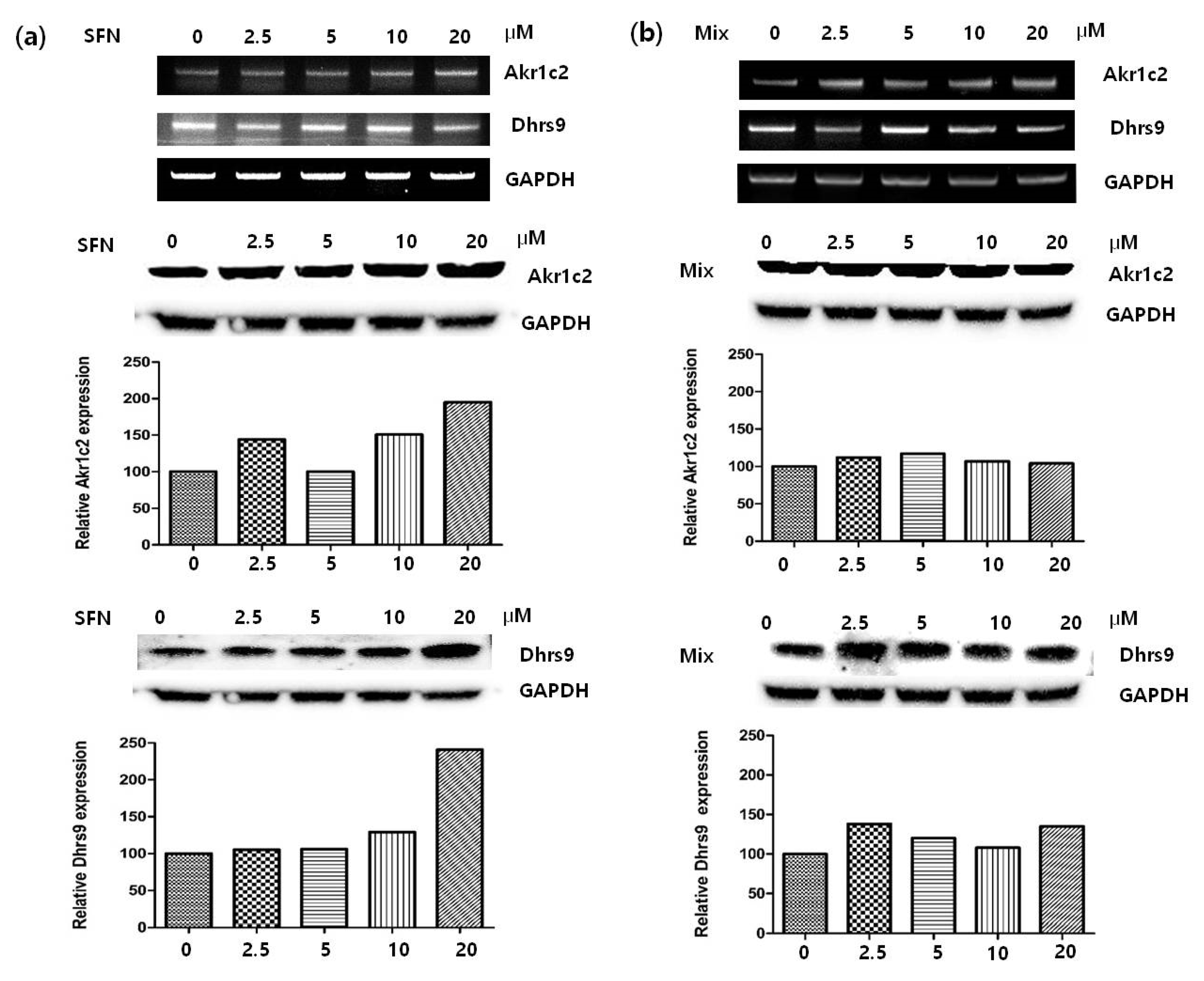
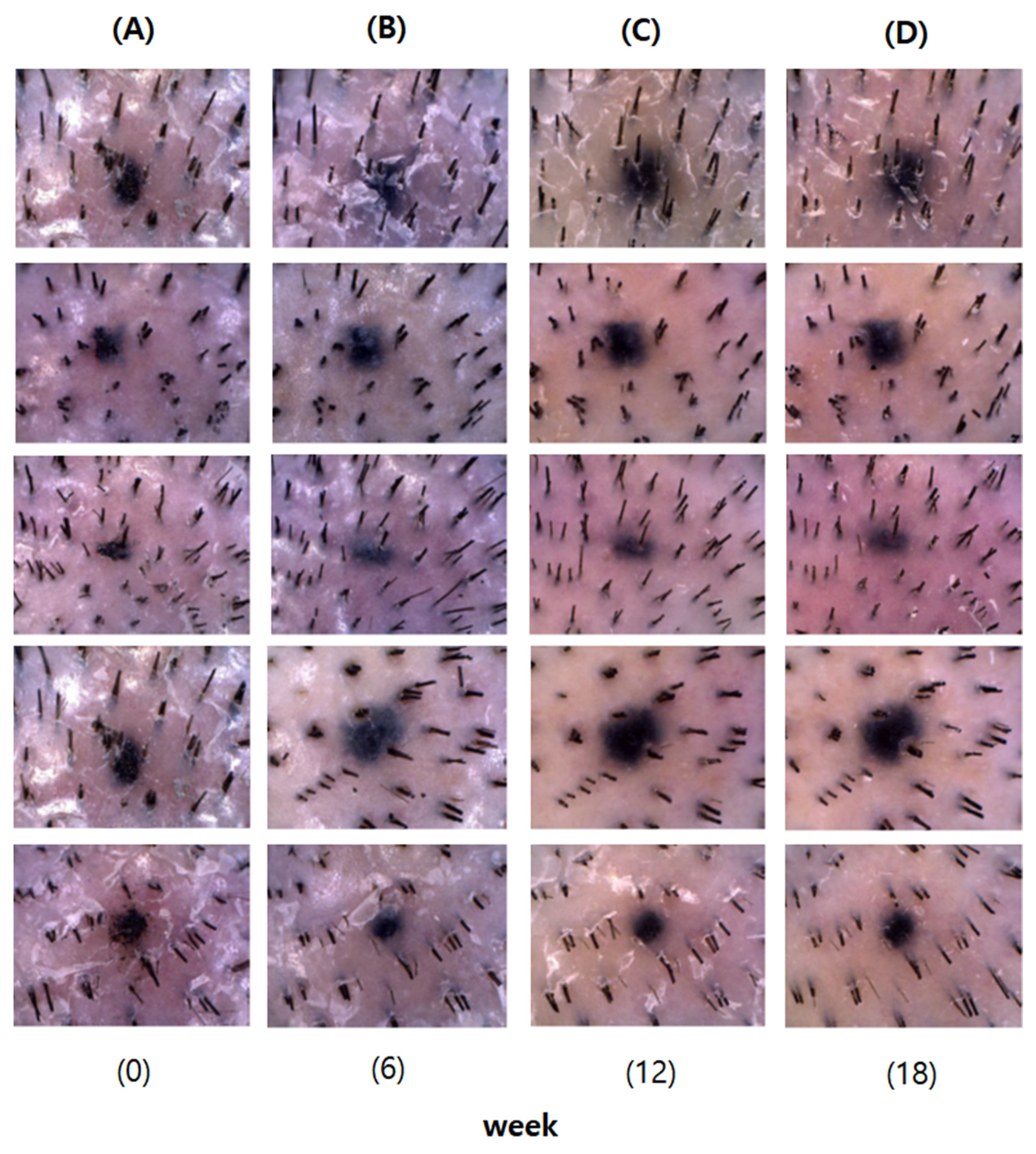
| Key Functional Agents | Major Ingredients |
|---|---|
| Hair loss conditioners | Sulforaphane, Dexpanthenol, L-Menthol |
| Skin conditioners | Trideceth-10, Sodium Hyaluronate |
| Thickners | Carbomer |
| Surfactants | PEG-60, Hydrogenated Castor Oil |
| Moisturizers | Glycerin |
| Point of View | Parietal, Evaluation Score (1) | p-Value (2) | Bangs, Evaluation Score (1) | p-Value (2) |
|---|---|---|---|---|
| Before using the test product (D0) | 0.00 ± 0.00 | - | 0.00 ± 0.00 | - |
| After 6 weeks of use (D42) | 0.61 ± 0.50 | <0.001 | 0.09 ± 0.29 | - |
| After 12 weeks of use (D84) | 0.74 ± 0.54 | <0.001 | 0.30 ± 0.47 | 0.008 |
| After 18 weeks of use (D236) | 0.87 ± 0.69 | <0.001 | 0.70 ± 0.56 | <0.001 |
| Point of View | Total Hair Count (N/cm2) (1) | p-Value (2) |
|---|---|---|
| Before using the test product (D0) | 28.48 ± 7.18 | - |
| After 6 weeks of use (D42) | 29.57 ± 6.95 | 0.008 |
| After 12 weeks of use (D84) | 29.52 ± 7.07 | 0.004 |
| After 18 weeks of use (D236) | 30.39 ± 6.95 | 0.001 |
Publisher’s Note: MDPI stays neutral with regard to jurisdictional claims in published maps and institutional affiliations. |
© 2021 by the authors. Licensee MDPI, Basel, Switzerland. This article is an open access article distributed under the terms and conditions of the Creative Commons Attribution (CC BY) license (https://creativecommons.org/licenses/by/4.0/).
Share and Cite
Park, Y.; Choi, K.; Kim, H.; Lee, J.; Park, G.; Kim, J. Sulforaphane, L-Menthol, and Dexpanthenol as a Novel Active Cosmetic Ingredient Composition for Relieving Hair Loss Symptoms. Cosmetics 2021, 8, 63. https://doi.org/10.3390/cosmetics8030063
Park Y, Choi K, Kim H, Lee J, Park G, Kim J. Sulforaphane, L-Menthol, and Dexpanthenol as a Novel Active Cosmetic Ingredient Composition for Relieving Hair Loss Symptoms. Cosmetics. 2021; 8(3):63. https://doi.org/10.3390/cosmetics8030063
Chicago/Turabian StylePark, Youngkum, Kanghyun Choi, Hyoseon Kim, Jihye Lee, Gyeryeol Park, and Junehyun Kim. 2021. "Sulforaphane, L-Menthol, and Dexpanthenol as a Novel Active Cosmetic Ingredient Composition for Relieving Hair Loss Symptoms" Cosmetics 8, no. 3: 63. https://doi.org/10.3390/cosmetics8030063
APA StylePark, Y., Choi, K., Kim, H., Lee, J., Park, G., & Kim, J. (2021). Sulforaphane, L-Menthol, and Dexpanthenol as a Novel Active Cosmetic Ingredient Composition for Relieving Hair Loss Symptoms. Cosmetics, 8(3), 63. https://doi.org/10.3390/cosmetics8030063





